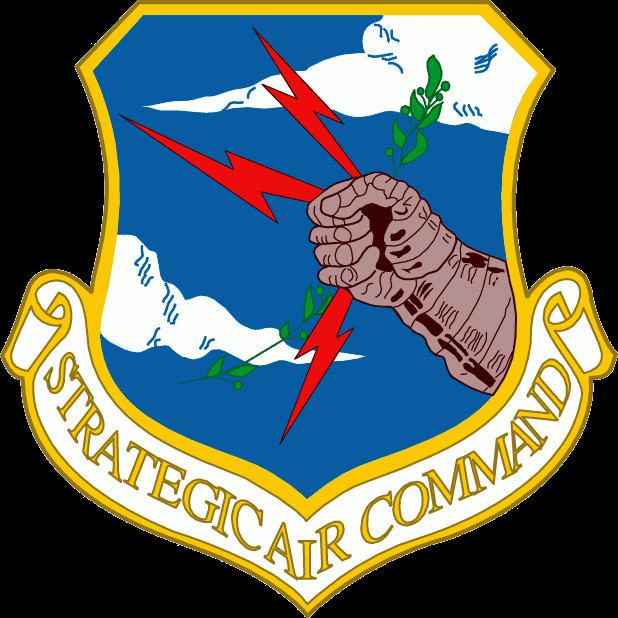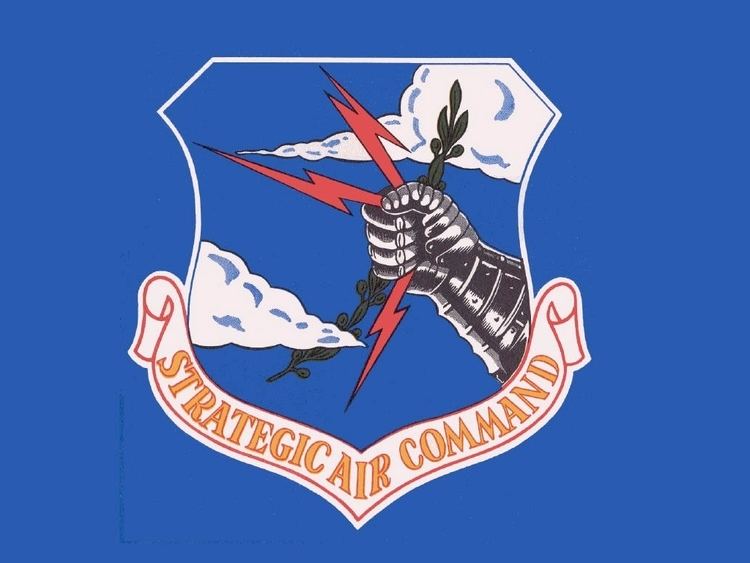Notable commander Curtis LeMay | Motto "Peace is Our Profession" Founded 21 March 1946 | |
 | ||
Country United States of America Type Major Command / Specified Command Garrison/HQ 9 November 1948: Offutt Air Force Base, Nebraska21 October 1946: Andrews Field, Maryland21 March 1946: Bolling Field, District of Columbia Similar United States Air Force, Tactical Air Command, United States Army Air, Eighth Air Force, Aerospace Defense Command | ||
Strategic Air Command (SAC) was both a Department of Defense Specified Command and a United States Air Force (USAF) Major Command (MAJCOM) responsible for Cold War command and control of two of the three components of the U.S. military's strategic nuclear strike forces, the so-called "Nuclear Triad," with SAC having control of land-based strategic bomber aircraft and intercontinental ballistic missiles or ICBMs (the other being submarine-launched ballistic missiles (SLBM)). SAC also operated all strategic reconnaissance aircraft, all strategic airborne command post aircraft, and all USAF aerial refueling aircraft, to include those in the Air Force Reserve (AFRES) and Air National Guard (ANG), with the exception of those KB-50, WB-50 and WB-47 aircraft operated through the mid and late 1960s, KC-97 aircraft through the late 1970s, and HC-130 and MC-130 aircraft operated by Tactical Air Command (TAC), Military Airlift Command (MAC), and from 1990 onward, the Air Force Special Operations Command (AFSOC), or associated AFRES (now Air Force Reserve Command (AFRC) and ANG aerial refueling aircraft operationally gained by TAC, MAC or AFSOC.
Contents

SAC primarily consisted of the Second Air Force (2AF), Eighth Air Force (8AF) and the Fifteenth Air Force (15AF), while SAC headquarters (HQ SAC) included Directorates for Operations & Plans, Intelligence, Command & Control, Maintenance, Training, Communications, and Personnel. At a lower echelon, headquarters divisions included Aircraft Engineering, Missile Concept, and Strategic Communications.

In 1992, as part of an overall post-Cold War reorganization of the U.S. Air Force, SAC was disestablished as both a Specified Command and as a MAJCOM, and its personnel and equipment redistributed among the Air Combat Command (ACC), Air Mobility Command (AMC), Pacific Air Forces (PACAF), United States Air Forces in Europe (USAFE), and Air Education and Training Command (AETC), while SAC's central headquarters complex at Offutt AFB, Nebraska was concurrently transferred to the newly created United States Strategic Command (USSTRATCOM), which was established as a joint Unified Combatant Command to replace SAC's Specified Command role.

In 2009, SAC's previous USAF MAJCOM role was reactivated and redesignated as the Air Force Global Strike Command (AFGSC), with AFGSC eventually acquiring claimancy and control of all USAF bomber aircraft and the USAF strategic ICBM force.

Background
The Strategic Air Forces of the United States during World War II included General Carl Spaatz's European command, United States Strategic Air Forces in Europe (USSTAF), consisting of the 8AF and 15AF, and the United States Strategic Air Forces in the Pacific (USASTAF) and its Twentieth Air Force (20AF).
The U.S. Army Air Forces' first mission in the Strategic Bombing Campaign in the European Theater during World War II included the VIII Bomber Command, which conducted the first European "heavy bomber" attack by the USAAF on 17 August 1942; the Ninth Air Force, which conducted the first Operation Crossbow "No-Ball" missions on 5 December 1943; the Twelfth Air Force; and the Fifteenth Air Force, which executed bombing operations on 2 November 1943 during Operation Pointblank.
The Operation Overlord air plan for the strategic bombing of both Germany and German military forces in continental Europe prior to the 1944 invasion of France used several Air Forces, primarily those of the USAAF and those of the Royal Air Force (RAF), with command of air operations transferring to the Supreme Commander of the Allied Expeditionary Force on 14 April 1944.
Planning to reorganize for a separate and independent postwar U.S. Air Force had begun by the fall of 1945, with the Simpson Board tasked to plan, "...the reorganization of the Army and the Air Force...". In January 1946, Generals Eisenhower and Spaatz agreed on an Air Force organization composed of the Strategic Air Command, the Air Defense Command, the Tactical Air Command, the Air Transport Command and the supporting Air Technical Service Command, Air Training Command, the Air University, and the Air Force Center.
Establishment and transfer to USAF
Strategic Air Command was originally established in the U.S. Army Air Forces on 21 March 1946, acquiring part of the personnel and facilities of the Continental Air Forces (CAF), the World War II command tasked with the air defense of the continental United States (CONUS). At the time, CAF headquarters was located at Bolling Field (later Bolling AFB) in the District of Columbia and SAC assumed occupancy of its headquarters facilities until relocating SAC headquarters (HQ SAC) to nearby Andrews Field (later Andrews AFB), Maryland as a tenant activity until assuming control of Andrews Field in October 1946.
SAC initially totaled 37,000 USAAF personnel. In addition to Bolling Field and, seven months later, Andrews Field, SAC also assumed responsibility for:
SAC also had seven additional CAF bases transferred on 21 March 1946 which remained in SAC through the 1947 establishment of the U.S. Air Force as an independent service. Those installations included:
On 31 March 1946, the following additional installation was also assigned to SAC:
Under the first SAC Commander in Chief, General George C. Kenney, initial units reporting to the Strategic Air Command headquarters on 21 March 1946 included the Second Air Force, the IX Troop Carrier Command and the 73d Air Division.
Fifteenth Air Force was assigned to SAC on 31 March (15th AF's 263rd Army Air Force Base Unit—with SAC's radar detachments—transferred the same date directly under HQ SAC ), while the IX Troop Carrier Command was inactivated the same date and its assets redistributed within SAC.
With postwar demobilization still underway, eight of the ten assigned bomb groups were inactivated before the Eighth Air Force was assigned to SAC on 7 June 1946
Despite the pressures of demobilization, SAC continued the training and evaluation of bomber crews and units still on active duty in the postwar Army Air Forces. Radar Bomb Scoring became the preferred method of evaluating bomber crews, with the last of 888 simulated bomb runs scored against a bombing site near San Diego, California during 1946, subsequently increasing to 2,449 bomb runs by 1947. In the wake of the successful employment of air-dropped nuclear weapons against Hiroshima and Nagasaki to effectively end World War II, SAC became the focus of the nation's nuclear strike capability, to the extent that Joint Chiefs of Staff (JCS) Publication 1259/27 on 12 December 1946 identified that, "...the 'air atomic' strategic air force should only come under the orders of the JCS."
In addition to the strategic bombing mission, SAC also devoted significant resources to aerial reconnaissance. In 1946, SAC's reconnaissance aircraft inventory consisted of F-2 photo variants of the C-45 Expeditor support aircraft, but by 1947 SAC had acquired an F-9C squadron consisting of twelve photo-reconnaissance variants of the B-17G Flying Fortress. An F-13 squadron, the F-13 later re-designated as the RB-29 Superfortress, was also established. SAC conducted routine aerial reconnaissance missions near the Soviet borders or near the 12-mile international waters limit, although some missions actually penetrated into Soviet airspace. The flight profiles of these missions—above 30,000 feet and in excess of 300 knots—made interception by Soviet air forces difficult until the Soviet's 1948 introduction of the MiG-15 jet fighter. Project Nanook, the Cold War’s first Top Secret reconnaissance effort, used the first RB-29 missions for mapping and visual reconnaissance in the Arctic and along the northern Soviet coast. Later missions were Project LEOPARD along the Chukchi Peninsula, followed by Projects RICKRACK, STONEWORK, and COVERALLS.
In 1946, the US possessed only nine atomic bombs and twenty-seven B-29s capable at any one time of delivering them. Furthermore, it was later determined that an attack by the 509th Composite Bomb Group during the 1947 to 1948 time frame would have required at least five to six days just to transfer custody of the bombs from United States Atomic Energy Commission (AEC) sites to SAC and deploy the aircraft and weapons to forward operating bases before launching nuclear strikes.
Unfortunately, postwar budget and personnel cuts had had an insidious effect on SAC as its Deputy Commander, Major General Clements McMullen, implemented mandated force reductions. This continued to wear down SAC as a command and morale plummeted. As a result, by the end of 1947, only two of SAC's eleven groups were combat ready. After the 1948 Bikini Atoll nuclear tests, the "Half Moon" Joint Emergency War Plan developed in May 1948 proposed dropping 50 atomic bombs on twenty Soviet cities, with President Harry S. Truman approving "Half Moon" during the June 1948 Berlin Blockade, (Truman sent B-29s to Europe in July). SAC also ordered special ELINT RB-29s to detect improved Soviet radars and, in cooperation with the 51st Air Force Base Unit, SAC also monitored radioactive fallout from Soviet atomic testing on Novaya Zemlya.
In terms of overall Air Force basing and infrastructure, SAC continued to acquire an ever-increasing share of USAF infrastructure and the USAF associated budget. In 1947, before the USAF was established as an independent service, construction commenced on Limestone AAF, Maine (later renamed Loring AFB), a new SAC installation specifically designed to accommodate the B-36 Peacemaker. Fort Dix AAF, New Jersey (later McGuire AFB); Spokane AAF, Washington (later Fairchild AFB); and Wendover Field, Utah (later Wendover AFB) were also transferred to SAC between 30 April and 1 September 1947. Following establishment of the USAF as a separate service, SAC bases in the United States consisted of:
